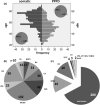Multimodal treatment of persistent postural-perceptual dizziness
- PMID: 32989916
- PMCID: PMC7749543
- DOI: 10.1002/brb3.1864
Multimodal treatment of persistent postural-perceptual dizziness
Abstract
Background: Persistent postural-perceptual dizziness (PPPD) is a chronic disorder with fluctuating symptoms of dizziness, unsteadiness, or vertigo for at least three months. Its pathophysiological mechanisms give theoretical support for the use of multimodal treatment. However, there are different therapeutic programs and principles available, and their clinical effectiveness remains elusive.
Methods: A database of patients who participated in a day care multimodal treatment program was analyzed regarding the therapeutic effects on PPPD. Vertigo Severity Scale (VSS) and Hospital Anxiety and Depression Scale (HADS) were assessed before and 6 months after therapy.
Results: Of a total of 657 patients treated with a tertiary care multimodal treatment program, 46.4% met the criteria for PPPD. PPPD patients were younger than patients with somatic diagnoses and complained more distress due to dizziness. 63.6% completed the follow-up questionnaire. All patients showed significant changes in VSS and HADS anxiety, but the PPPD patients generally showed a tendency to improve more than the patients with somatic diagnoses. The change in the autonomic-anxiety subscore of VSS only reached statistical significance when comparing PPPD with somatic diagnoses (p = .002).
Conclusions: Therapeutic principles comprise cognitive-behavioral therapy, vestibular rehabilitation exercises, and serotonergic medication. However, large-scale, randomized, controlled trials are still missing. Follow-up observations after multimodal interdisciplinary therapy reveal an improvement in symptoms in most patients with chronic dizziness. The study was not designed to detect diagnosis-specific effects, but patients with PPPD and patients with other vestibular disorders benefit from multimodal therapies.
Keywords: cognitive-behavioral therapy; functional dizziness; multimodal treatment; persistent postural-perceptual dizziness; vestibular rehabilitation.
© 2020 The Authors. Brain and Behavior published by Wiley Periodicals LLC.
Conflict of interest statement
The authors declare no financial or other conflicts of interest.
Figures


References
-
- Andersson, E. (1993). The hospital anxiety and depression scale: Homogeneity of the subscales. Social Behavior and Personality: An International Journal, 21, 197–204. 10.2224/sbp.1993.21.3.197 - DOI
-
- Dietzek, M. , Finn, S. , Karvouniari, P. , Zeller, M. A. , Klingner, C. M. , Guntinas‐Lichius, O. , … Axer, H. (2018). In older patients treated for dizziness and vertigo in multimodal rehabilitation somatic deficits prevail while anxiety plays a minor role compared to young and middle aged patients. Frontiers in Aging Neuroscience, 10, 345 10.3389/fnagi.2018.00345 - DOI - PMC - PubMed
Publication types
MeSH terms
LinkOut - more resources
Full Text Sources
Medical
Miscellaneous

